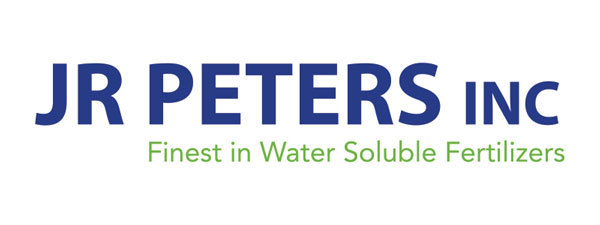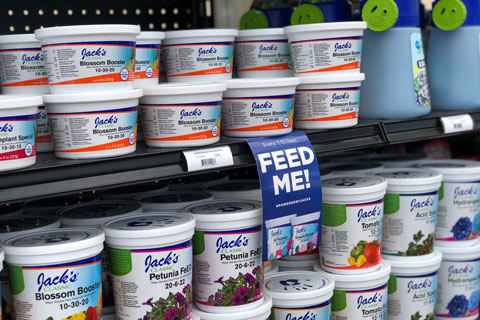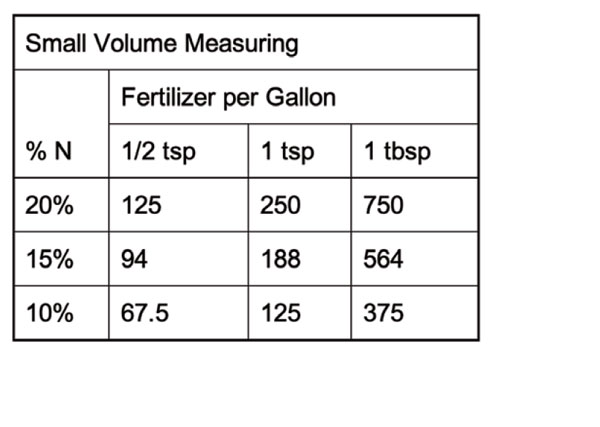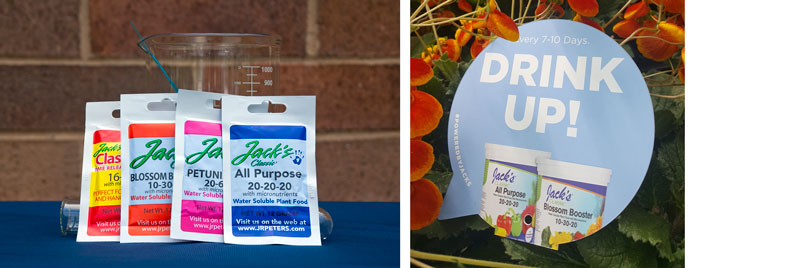4/1/2019
Plants That WOW
Dr. Cari Peters & John Raymond

The average customer who comes into your garden center may have found you by many different paths: a print advertisement, your Insta feed or garden envy of the neighbor on their street. Overall, they’re looking for that WOW plant.
Healthy, happy-looking plants in your store inspire people to create the ideal space in their yard. In the greenhouse, you spend the time growing them, choosing the right container or pot to attract interest and displaying them in just the right space in your garden center. We live in a competitive world and there’s a reason consumers choose to spend their time and money in your store, instead of that big box down the street: the quality and variety you offer and the expertise of your staff, which can help them create that backyard oasis. The next step is to help your customers maintain that “wow” factor all season long.

Plants Need Food, Too!
It’s called plant “food” for a reason. Fertilizers (sometimes referred to as plant food) are designed to provide all the essential nutrients the plant will need to grow and stay healthy and green throughout the entire season. Of course, most homeowners know plants need water and a favorable location, but the concept of feeding is often unclear or all together forgotten.
Finished plants have been cared for by plant masters like you. They have a healthy and developed root system that has most likely been fertilized on a regular basis. These finished plants need a higher level of fertility than plants in their younger growth stages.
Retail water-soluble fertilizer formulas are usually grouped according to their effect or for a specific plant type. Typically, an all-purpose fertilizer like 20-20-20 can be used in many different environments, from bedding plants in the soil or a container filled with potting mix. The balanced ratio of nitrogen, phosphorus and potassium (N-P-K) will promote green leaf growth, a strong root system and continual blooming throughout the growing season.
A blossom-booster formula is designed to do just that, help stimulate the plant to start and continue to bloom with strong, bright colors. The formulas of these blossom-booster products usually have a higher middle number (percentage of P2O5) and a ratio of 1:3:2 Nitrogen:Phosphorus:Potassium in order to keep the plant in the flowering stage. Plant-specific formulas are designed for groups of plants that may need a specific blend of nutrients to perform their best in the landscape.
Petunia-specific products with formulations like 20-6-22 have the right balance of macronutrients to keep the plant healthy and blooming, while also having extra iron (Fe) to keep the soil pH low. This is critical to make sure that the iron is available for plants like petunias, calibrachoas and bacopas because these types of plants have a tendency to be inefficient in their iron uptake if the pH in the soil is too high. Fertilizer products designed for tomatoes, peppers and other vegetables, as well as orchid, citrus plants, palm and others, have the right balance of nutrients specific to those categories of plants.
So just take that in—there are a lot of different types of water-soluble fertilizer products available for people to keep the plants they buy from you happy. Unfortunately, many busy homeowners who want their garden healthy and beautiful don’t necessarily have the time to apply water-soluble fertilizer as often as they should or at all (GASP!). The good news for folks like this is that there are time-release fertilizers that are a wonderful way to ensure their plants receiving a small level of nutrition throughout the entire season with just one application. These products can be incorporated in the garden soil or container around the root zone, or can also be applied as a top dress to the pot.
How-To Tips
General instructions for any retail fertilizer are simple and based on the concept of how often you feed and the season.
For outdoor summer or warm-season plants: If you’re feeding once a week or every seven to 10 days, use 1 tablespoon per gallon of water. If you’re feeding every time you’re watering your plant, then you’re stepping it up to the next level and following the Constant Liquid Feed method (CLF)—that’s right, the consumer is a professional grower at home. Use 1 teaspoon per gallon of water every time the plant gets water. For indoor or dormant-season plants, feed at ½ teaspoon per gallon of water every seven to 10 days.
Let’s get science-y. Here are the nitrogen parts per million (ppm) when you do that:

A Lasting Impression
Lecturing your customers on how they have to maintain their plants with the right type of fertilizer may not be the kind of fun conversation you want to bombard your customer with as they’re checking out with a trunk full of plants. However, reminding them to keep the plants well fed and making a selection of plant foods available for them to choose from can dramatically increase their success at home, which is what we’re all after.
Help them on the path to success by offering high-quality nutrients and you’ll see happy customers that will return year after year. GP
Dr. Cari Peters is part of the third generation of her family's company―J.R. Peters. She’s currently in charge of formula research and development and laboratory services in Allentown, Pennsylvania. Cari is the newest generation of blue hands constantly looking for ways to help growers feed all types of plants more efficiently using Jacks fertilizers.
John Raymond is the President and COO of JR Peters. After years of trying to deny it, he realized his passion for fertilizer and the horticulture industry was his true calling. John is in charge of all of the JR Peters production and manufacturing and just can’t stop talking about the blue stuff!
Get the Conversation Started
Below are some examples to help start the conversation about fertilizing plants at home:
• Let the plant speak for itself! Use a clever thought bubble—as a plant stake or hanging basket tag— to remind customers that, yes indeed, all plants need food, not just Audrey II from “Little Shop of Horrors.” You can even make these types of signage yourself with plant-specific feeding tips.
• Try some at home. Sample packets are a great way to entice the customer to try fertilizing at home and hopefully come back to your store for more. You can attach the sample packet to a basket or give a free pack to each customer with a plant purchase—everyone loves freebies! One of these sample packets will make 1 gallon of water and gets them immediately thinking of the steps they need to do in order to keep their plants looking their best.
• Last but not least, the quality of the nutrients you use to feed your plants in the greenhouse and garden center should be similar to what you’re offering to your customers. Professional-grade formulas do exist for the homeowner. Customers want to use what you use!
